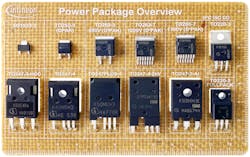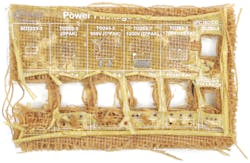Erasing E-Waste: Is a Circular Economy Possible for Power Electronics?
What You'll Learn
- Why the electronics industry is struggling to clean up its act
- The role that biodegradable materials can play in the sector
- An inside look at Infineon’s efforts in sustainable electronics
Power electronics are one of the keys to the future of clean energy, giving a jolt to everything from solar, wind, and other renewable-energy systems to electric vehicles (EVs). But they’re not exactly sustainable.
It takes a huge amount of electricity to run the machinery to mass-produce power semiconductors inside them. The chips are soldered to printed circuit boards (PCBs) fabricated out of rare minerals, plastics, and toxic chemicals. At the end of their useful lives, the devices are incinerated or dumped in landfill, leaching toxins into soil. Once discarded, none of the components inside are reused and there’s no recycling of the resources used to manufacture these devices. On top of that, all of the energy consumed throughout its lifecycle is lost.
Consequently, electronic waste, or e-waste, is washing across the globe. In 2020, a U.N. report warned that over 50 million tons of e-waste were dumped worldwide in 2019 alone. As it happened, only about 17% of the raw materials and other components inside these devices were recycled.
Given electronics represent one of the fastest-growing waste streams in the world, it’s worth asking whether a sustainable electronics industry is even possible at this point. And what will it take to get there?
Andreas Kopp, head of product management for discrete semiconductors in Infineon’s Green Industrial Power unit, said the electronics industry is still trying to work out its vision for what to do with electronic waste before it’s discarded or incinerated. What he knows for sure is that we need to start somewhere.
“When it comes to the circular economy—and those concepts of reduce, reuse, and recycle—we wanted to know how we could contribute as a semiconductor company. How can our components be reused? That’s where we started.”
Introducing Soluboard: The Biodegradable PCB
The world’s electronic waste problem has not peaked, due to new devices being in constant demand. The U.N. forecasts that, at current growth rates, the world will throw out close to 75 million tons of electronics in 2030 alone.
To help make the electronics industry more sustainable, Infineon recently announced plans to use circuit boards based on a biodegradable substrate designed by startup Jiva Materials, which the company claims takes less of a toll on the environment.
Instead of the glass-reinforced resin laminate called FR-4 widely used in modern circuit boards, the new substrate, called Soluboard, is based on a compostable organic material enclosed in a non-toxic polymer. The polymer breaks down when submerged in hot water, leaving behind a fibrous material that can be recycled with relative ease. Electronic components soldered on to the board can then be recovered and reused (Fig. 1).
The ability to recover power electronics from the PCB was the most important factor for Infineon. The company is also researching the reusability of its discrete power devices at the end of their service life and, in doing so, creating a more circular economy for the electronics industry.
Initially, Infineon said that it will use biodegradable material for its demo and evaluation boards. But it’s also exploring the possibility of applying Jiva’s material to all products with a PCB in the future.
Infineon has produced three different demo boards using the technology, and it plans to expand the offering in the coming years. More than 500 units are already in use to showcase its discrete power portfolio, including one board that features components for refrigerator applications.
How PCB Recycling is Falling Short on Sustainability
Once an electronic device completes its useful lifespan, it can be difficult to dispose of the circuit board inside safely and sustainably. The device is at best stashed away in storage. The majority are scrapped in landfill.
Recycling the copper, aluminum, tin, gold, and other rare minerals used in its manufacture and recovering the components inside it is another path for the device to travel at the end of life. But it still poses risks to the environment.
The recycling process starts with prying the PCB out of the device. Then it’s physically drilled into and dismantled, with batteries and other components plucked off so that they can be recycled separately or reused.
Once everything of value is removed from the surface, the circuit board is shredded into flakes and subsequently incinerated to recover the precious metals that are then roasted, smelted, and refined for reuse in future products. The recycling of the non-metal portion of circuit boards, which mostly consists of plastics, is rare. Most of the non-metal wastes stemming from a PCB are committed to landfill.
As a result, recycling isn’t actually that sustainable. It takes large amounts of electricity to shred and incinerate the PCB to the point where the precious metals can be separated from everything else. Water used throughout the process can contain solvents and other hazardous chemicals, so it must be treated before being released. Fumes from burning the electronics are toxic, too, and must be filtered to prevent pollution.
“It’s a very rough procedure and very energy intensive,” said Kopp.
According to Infineon, Jiva’s technology presents a new way for the electronics industry to recycle circuit boards without incinerating or shredding. It could also make it easier for engineers to adopt recycled materials in new products.
A Circuit Board Debuts for the Circular Economy
In Soluboard, the glass fiber and synthetic resin used in today’s circuit boards are replaced with natural fibers and a polymer that resembles plastic but breaks down when soaked in boiling water.
The dissolved polymer solution can be disposed of through the traditional wastewater recycling process, while the natural fibers could be composted or reused. And valuable metal salvaged from the PCB and other components that have residual value can be recycled or reused (Fig. 2). "Adopting a water-based recycling process could lead to higher yields in the recovery of valuable metals," said Jonathan Swanston, Jiva's co-founder and CEO.
It can be difficult to disassemble the chips soldered on a PCB. Infineon said the biodegradable material presents a way to separate the parts with relative ease, potentially giving them a better opportunity for a second life.
If nothing else, Jiva claims Soluboard results in 60% less carbon emissions when manufactured than the process to produce traditional PCB substrates. Furthermore, more than 600 grams of plastic per square meter of PCB can be saved by replacing FR-4 materials with the new material.
One of the weaknesses of the Soluboard is that it’s currently only suited for single- and double-sided circuit boards. Most modern boards contain several layers of wiring with insulating layers between them to transfer power and signals.
In contrast to high-speed PCBs used in data centers and PCs, power electronics is all about power density. As a result, characteristics such as heat dissipation and current capacity matter most in the PCB.
But even USB Type-C fast chargers require circuit boards with several layers of wiring, said Kopp. The inability to create high-density circuit boards limits Jiva’s Soluboard to prototyping at this point.
Biodegradable PCB: Will It Work for Power Electronics?
Stress tests with Soluboard are ongoing. Pending the results, Infineon plans to provide guidance on the reuse and recycling of power semiconductors removed from the PCB, which could significantly extend the parts’ lifespan.
Infineon intends to evaluate long-term reliability of the PCB and the durability of the high-voltage power devices soldered to it. It’s looking for more insight into whether Jiva’s technology can handle the harsh environments in which Infineon’s chips are used. Other characteristics it wants to evaluate include the ability to dissipate heat and mechanical robustness. It’s unclear how Jiva stands up to traditional PCB materials.
Since its discrete power devices aren’t designed to be dunked in water and stripped from the circuit board, Infineon is eager to evaluate how the recycling process will affect them and whether it should anticipate any damage.
Unclear is “whether they can be reused as-is or if we see weak points in the devices and where we can maybe see some improvement potential to make them stronger and enable a second life,” stated Kopp.
It’s too early to tell whether the company’s discrete power devices can survive a second life. But not all power components are created equal. For instance, the power chips in consumer electronics only need to last about a decade and aren’t in constant use. They aren’t subject to the severe temperatures, sudden shocks, vibrations, or other harsh conditions that can stress out Infineon’s industrial- and automotive-grade chips, said Kopp. “So, maybe these would be relatively easy to qualify for a second life.”
He noted that “this has never been done before. We’re learning every step on this journey.”
Kopp added, “We still don’t know if a second life will be possible at all. But so long as it can survive a single lifecycle, then the question becomes, ‘Can we requalify the part before it gets used a second time, to make sure that when it’s in the field there is no risk for our customers to take?’” Plus, “if we want to give parts a second life, we have to ensure that they will work in demanding applications.”
Can the Electronics Industry Out-Innovate E-Waste?
Lastly, will it even make sense for Infineon—commercially and financially—to give its components a second life? And will it be worth it for customers to recycle and reuse components in their products?
What’s unclear is whether any significant value can even come of recycling end-of-life components this way. The collection and recovery process may cost many times the residual value of the parts.
For Kopp, the key is figuring out the process of recovering the components from its customers and then requalifying them before they hit the market for the second time. Apple and major electronics companies may have the infrastructure to collect and disassemble their devices and strip the parts and other raw materials. But it may prove more difficult for a semiconductor company with tens of thousands of customers around the world to scrape together electronic waste for recycling or reuse.
Kopp said that discrete power devices based on new wide-bandgap semiconductors—SiC and GaN—are potentially prime candidates for recovery and reuse because they’re pricier than silicon.
“Reusing seems to make sense with these components. Or if the power components inside an EV charger make up 10% to 15% of the overall cost, then maybe it starts to make sense to think about reusing them.”
Long-term, it’s worth wondering whether the concept of a circular economy is compatible with how the electronics industry works at all. While it will positively impact the environment, there may not be a lot of business incentive for semiconductor and other electronics firms to convince their customers to reduce, reuse, and recycle. They’re all pushing customers to buy the latest devices in the largest quantities possible.
Given the problem electronic waste poses to the environment, the lack of success in addressing it, and current incentives, the concept of sustainable electronics can feel like a long shot, admits Kopp.
But he’s not about to bet against one of the most innovative industries in the world. “The electronics industry always finds a way through innovation.”
About the Author
James Morra
Senior Editor
James Morra is the senior editor for Electronic Design, covering the semiconductor industry and new technology trends, with a focus on power electronics and power management. He also reports on the business behind electrical engineering, including the electronics supply chain. He joined Electronic Design in 2015 and is based in Chicago, Illinois.



